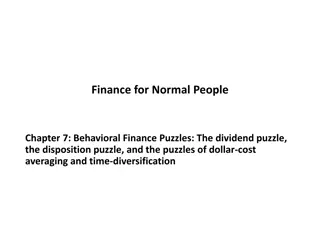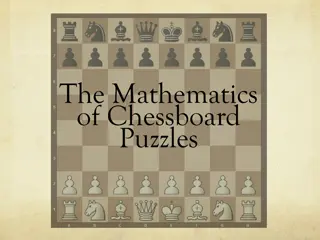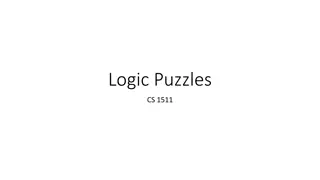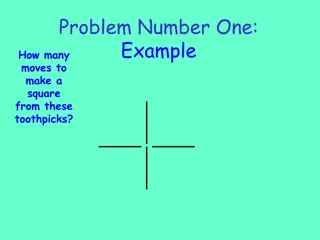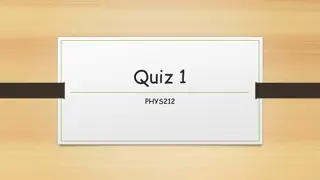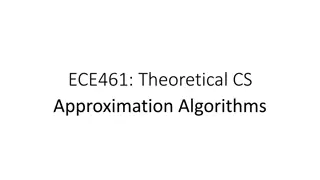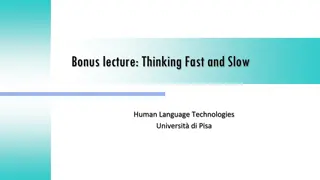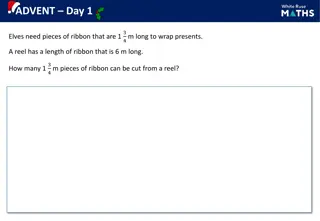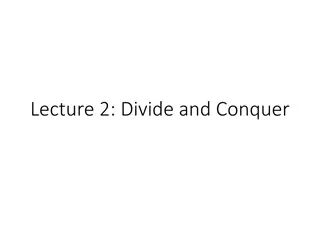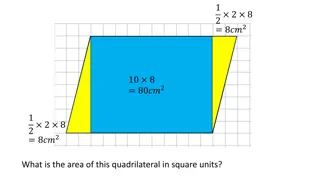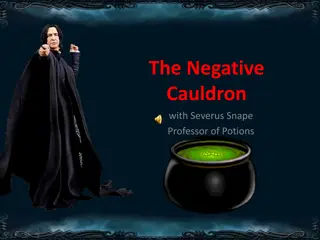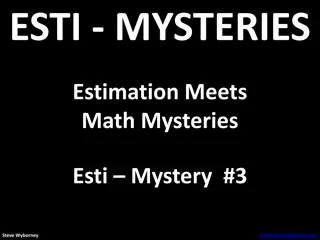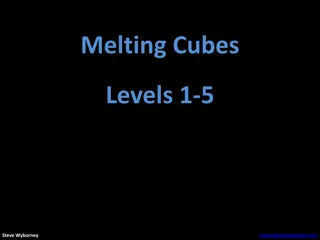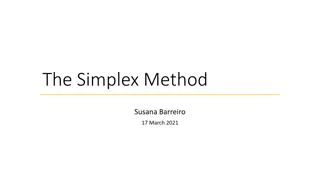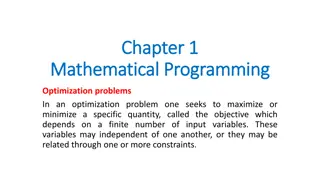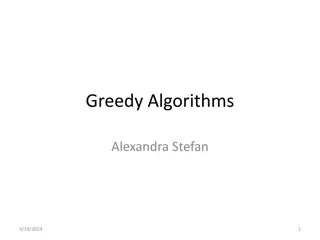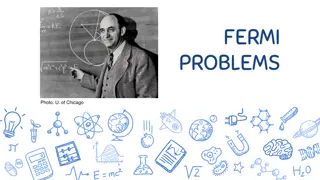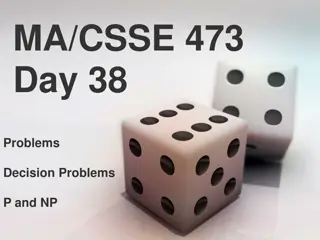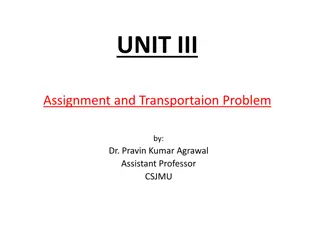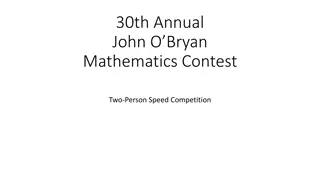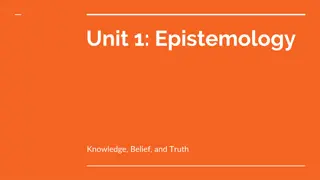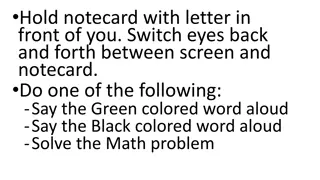Intriguing Puzzles and Challenging Problems
The discussion revolved around reductions via gadgets and efficient certification in the last session. A puzzling scenario of ten castaways on a deserted island, dividing coconuts, and encountering a mischievous monkey led to a brain-teasing problem. Additionally, insights into the complexity classes P and NP, focusing on the concept of NP-completeness, were explored by computer scientists.
Download Presentation

Please find below an Image/Link to download the presentation.
The content on the website is provided AS IS for your information and personal use only. It may not be sold, licensed, or shared on other websites without obtaining consent from the author. Download presentation by click this link. If you encounter any issues during the download, it is possible that the publisher has removed the file from their server.
E N D
Presentation Transcript
What did we talk about last time? Reductions via gadgets Efficient certification
Ten people are marooned on a deserted island They gather many coconuts and put them all in a community pile They are so tired that they decide to divide them into ten equal piles the next morning One castaway wakes up hungry and decides to take his share early After dividing up the coconuts, he finds he is one coconut short of ten equal piles He notices a monkey holding one coconut He tries to take the monkey's coconut so that the total is evenly divisible by 10 However, when he tries to take it, the monkey hits him on the head with it, killing him Later, another castaway wakes up hungry and also decides to take his share early On the way to the coconuts he finds the body of the first castaway and realizes that he is now be entitled to 1/9 of the total pile After dividing them up into nine piles he is again one coconut short of an even division and tries to take the monkey's (slightly) bloody coconut Again, the monkey hits the second man on the head and kills him Each of the remaining castaways goes through the same process, until the 10thperson to wake up realizes that the entire pile for himself What is the smallest number of coconuts in the original pile (ignoring the monkey's)?
While trying to figure out if P= NP, computer scientists have considered the hardest problems in NP What are those? A hardest problem Xin NPhas the following properties: X NP For all Y NP, Y PX In other words, it s a problem in NPthat we can reduce all other problems in NP to The hardest problems in any class are its "complete" problems Thus, we call the hardest problems in NPthe NP-complete problems
Claim:Suppose Xis an NP-completeproblem. Xis solvable in polynomial time if and only if P = NP. Proof: If P = NP, then Xcan be solved in polynomial time, since X NP. Conversely, suppose that Xcan be solved in polynomial time. For all other problems Y NP, Y PX. Thus, all problems Y can be solved in polynomial time and NP P. Since we already know that P NP, it would be the case that P = NP.
It might seem strange that there's a layer of problems that are all the "hardest" in NP Wouldn't it be possible for there to be lots of problems in NP that can't be reduced to each other? Thus, we could imagine lots of incomparable problems floating around, none of which are clearly harder than the others Or, there could be infinite problems in NP, with each one strictly harder than the previous!
We want a problem that builds intuition about how we might be able to encode any problem in NP Consider a circuit A labeled, directed, acyclic graph with sources (no incoming edges) that are 0, 1, or the name of a variable Every other node corresponds to operators (AND), (OR), and (NOT) A single node with no outgoing edges is the output
The circuit satisfiability problem takes such a circuit as input and asks if there is an assignment of values to inputs that causes the output to be 1 If there is, the circuit is satisfiable A satisfying assignment is one that results in this output of 1 Circuit satisfiability is NP-completebecause we can reduce any problem in NPto it
Any algorithm that takes a fixed number nof bits as input and produces a "yes" or "no" answer can be represented by this kind of circuit The circuit is the same as an algorithm because its output is 1 on precisely the inputs for which the algorithm outputs "yes" If the algorithm takes a number of steps that is polynomial in n, the circuit must have polynomial size The Cook-Levin theorem goes into careful detail about how to construct such a circuit from an algorithm
Proof: 3-SAT is in NP since we can verify in polynomial time that a truth assignment satisfies a given set of clauses. By reducing circuit satisfiability to 3-SAT, we will thus prove that 3- SAT is NP-complete. 1. Turn any circuit into an equivalent instance of SAT with at most 3 variables per clause 2. Turn any instance of SAT where each clause has at most 3 variables into an equivalent instance with exactly 3 variables
Make variable xvfor each node v of Kto hold the truth value for that node If v is a NOT and its entering edge comes from u, then we need ??= ??, for that, we add clauses (?? ??)and (?? ??) If v is an OR and its entering edges come from uand w, we need ??= ?? ??, for that we add clauses (?? ??), (?? ??), and (?? ?? ??) If v is an AND and its entering edges come from u and w, we need ??= ?? ??, for that we add clauses (?? ??), (?? ??), and ( ) ?? If v is a 1 or a 0, we set it to the clause ??or ??, respectively If v is the output node, we add the clause ??to force it to 1 ?? ??
3-SAT has exactly three variables for each clause, but some of our clauses have one or two variables Create four new variables: ?1,?2,?3,?4 Create four clauses for each: ( ?1 ?3 ?4), ( ?1 ?3 ?4), ( ?1 ?3 ?4), and ( ?1 ?3 ?4) These clauses force ?1= ?2= 0 Then, for two-term clause, we OR ?1with it, and for any single term clause we OR ?1 ?2with it This new formula is satisfiable if and only if the original circuit was, and we were able to construct it in polynomial time. Thus, circuit SAT P3-SAT, and 3-SAT is NP-complete.
Earlier, we showed: 3-SAT Pindependent set Pvertex cover Pset cover By the transitivity of polynomial-time reduction, circuit SAT is reducible to all of these problems Thus, all of these problems are NP-complete
Given a problem Xthat might be NP-complete 1. Prove that X NP 2. Choose a problem Ythat is known to be NP-complete 3. Prove that Y PX Specifically, consider an arbitrary instance sYof Y and show how to construct in polynomial time an instance sXof X such that: a. If sYis a "yes" instance of Y, then sXis a "yes" instance of X b. If sXis a "yes" instance of X, then sYis a "yes" instance of Y
The weighted interval scheduling problem extends interval scheduling by attaching a weight (usually a real number) to each request Now the goal is not to maximize the number of requests served but the total weight Our greedy approach is worthless, since some high value requests might be tossed out We could try all possible subsets of requests, but there are exponential of those Dynamic programmingwill allow us to save parts of optimal answers and combine them efficiently
We have nrequests labeled 1, 2,, n Request i has a start time siand a finish time fi Request i has a value vi Two intervals are compatible if they don't overlap
Let's go back to our intuition from the unweighted problem Imagine that the requests are sorted by finish time so that f1 f2 fn We say that request i comes before request jif i < j, giving a natural left-to-right order For any request j, let p(j) be the largest index i < jsuch that request i ends before jbegins If there is no such request, then p(j) = 0
Index 2 p(1) = 0 1 4 p(2) = 0 2 4 p(3) = 1 3 7 p(4) = 0 4 2 p(5) = 3 5 1 p(6) = 3 6
Iterative-Compute-Opt M[0] = 0 For j = 1 up to n M[j] = max(vj + M[p(j)], M[j 1]) Algorithm is O(n)
Find-Solution(j, M) If j = 0 then Output nothing Else if vj + M[p(j)] M[j 1] then Output j together with the result of Find-Solution(p(j)) Else Output the result of Find-Solution(j 1) Algorithm is O(n)
The key element that separates dynamic programming from divide-and-conquer is that you have to keep the answers to subproblems around It's not simply a one-and-done situation Based on which intervals overlap with which other intervals, it's hard to predict when you'll need an earlier M[j] value Thus, dynamic programming can often give us polynomial algorithms but with linear (and sometimes even larger) space requirements
Weighted interval scheduling follows a set of informal guidelines that are essentially universal in dynamic programming solutions: There are only a polynomial number of subproblems 2. The solution to the original problem can easily be computed from (or is one of) the solutions to the subproblems There is a natural ordering of subproblems from "smallest" to "largest" 4. There is an easy-to-compute recurrence that lets us compute the solution to a subproblem from the solutions of smaller subproblems 1. 3.
Let's say that we have a series of n jobs that we can run on a single machine Each job i takes time wi We must finish all jobs before time W We want to keep the machine as busy as possible, working on jobs until as close to W as we can
If job n is not in the optimal set, OPT(n, W) = OPT(n 1, W) If job n is in the optimal set, OPT(n, W) = wn + OPT(n 1, W wn) We can make the full recurrence for all possible weight values: If w < wi, then OPT(i, w) = OPT(i 1, w) Otherwise, OPT(i, w) = max(OPT(i 1, w), wi + OPT(i 1, w wi))
Create 2D array M[0n][0W] For w from 1 to W Initialize M[0][w] = 0 For i from 1 to n For w from 0 to W If w < wi, then OPT(i, w) = OPT(i 1, w) Else OPT(i, w) = max(OPT(i 1, w), wi + OPT(i 1, w wi)) Return M[n][W]
We're building a big 2D array Its size is nW n is the number of items W is the maximum weight Actually, it's got one more row and one more column, just to make things easier The book makes this array with row 0 at the bottom I've never seen anyone else do that I'm going to put row 0 at the top
0 0 0 0 0 0 0 0 0 0 0 0 0 1 0 2 0 0 0 0 i 1 0 i 0 0 0 0 n 0 w- wi 0 1 2 w W
The algorithm has a simple nested loop The outer loop runs n + 1 times The inner loop runs W + 1 times The total running time is O(nW) The space needed is also O(nW) Note that this time is not polynomial in terms of n It's polynomial in n and W, but W is the maximum weight Which could be huge! We call running times like this pseudo-polynomial Things are fine if W is similar to n, but it could be huge!
Weights: 1, 4, 8, 2, 10 Maximum: 15 Create the table to find all of the optimal values that include items 1, 2, , i for every possible weight w up to 15
i wi 0 1 2 3 4 5 6 7 8 9 10 11 12 13 14 15 0 0 0 0 0 0 0 0 0 0 0 0 0 0 0 0 0 0 1 1 2 8 3 4 4 2 5 10
The knapsack problem is a classic problem that extends subset sum a little As before, there is a maximum capacity W and each item has a weight wi Each item also has a value vi The goal is to maximize the value of objects collected without exceeding the capacity like Indiana Jones trying to put the most valuable objects from a tomb into his limited-capacity knapsack
The knapsack problem is really the same problem, except that we are concerned with maximum value instead of maximum weight We need only to update the recurrence to keep the maximum value: If w < wi, then OPT(i, w) = OPT(i 1, w) Otherwise, OPT(i, w) = max(OPT(i 1, w), vi + OPT(i 1, w wi))
Items (wi, vi): (1, 15) (5, 10) (3, 9) (4, 5) Maximum weight: 8 Create the table to find all of the optimal values that include items 1, 2, , i for every possible weight w up to 8
i wi vi 0 1 2 3 4 5 6 7 8 0 0 0 0 0 0 0 0 0 0 0 0 1 1 15 0 2 5 10 0 3 3 9 0 4 4 5 0
An alignment is a list of matches between characters in strings X and Y that doesn't cross Consider: stop- -tops This alignment is (2,1), (3,2), (4,3)
Some optimal alignment will have the lowest cost Cost: Gap penalty > 0, for every gap Mismatch cost pq for aligning p with q pp is presumably 0 but does not have to be Total cost is the sum of the gap penalties and mismatch costs
Let OPT(i, j) be the minimum cost of an alignment of the first i characters in X to the first j characters in Y In case 1, we would have to pay a matching cost of matching the character at i to j In cases 2 and 3, you will pay a gap penalty ?????+ OPT ? 1,? 1 ? + OPT ? 1,? ? + OPT ?,? 1 OPT ?,? = min
We do our usual thing Build up a table of values with m + 1 rows and n + 1 columns In row o, column i has value i to build up strings from the empty string In column o, row i has value i to build up strings from the empty string The other entries (i,j) can be computed from (i -1, j 1), (i 1, j), (i, j 1)
Create array A[0...m][0...n] For i from 0 to m Set A[i][0]= i For jfrom 0 to n Set A[0][ j]= j For i from 1 to m For jfrom 1 to n Set A[i][j]= min(?????+A[i-1][j-1], + A[i-1][j], + A[i][j- 1]) Return A[m][n]
0 0 2 (j -1) j n 1 2 2 i 1 (i-1) i i m m 0 1 2 j - 1 j n
Find the minimum cost to align: "garbage" "ravaged" The cost of an insertion (or deletion) is 1 The cost of replacing any letter with another letter is 1 The cost of "replacing" any letter with itself is 0
g a r b a g e 0 1 2 3 4 5 6 7 r 1 a 2 v 3 a 4 g 5 e 6 d 7
A flow network is a weighted, directed graph with positive edge weights Think of the weights as capacities, representing the maximum units that can flow across an edge It has a sources (where everything comes from) And a sinkt (where everything goes to) Some books refer to this kind of flow network specifically as an st-flow network




